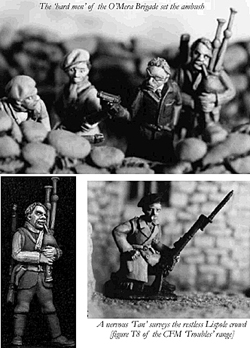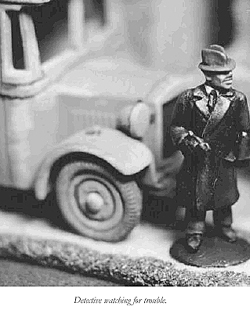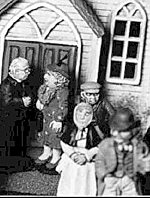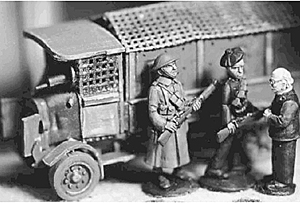"It is with artillery that war is made!"
--EMPEROR NAPOLEON
 RIC ‘Auxie’ (armed with Lewis gun) and British Regular stand guard [figures T9 & T17 of CFM’s ‘Troubles’ range]
RIC ‘Auxie’ (armed with Lewis gun) and British Regular stand guard [figures T9 & T17 of CFM’s ‘Troubles’ range]
BACKGROUND
At Easter 1916 Irish nationalists in Dublin rose in rebellion against the authority of the British Crown and seized control of several significant public buildings in the city. For the Irish nationalists the uprising was an attempt, albeit a desperate and not very well coordinated one, to shake off centuries of British rule while Britain was distracted by the Great War.
For the British the rebellion was seen as an act of treachery. The subsequent fighting to suppress the rebellion resulted in the deaths of hundreds of nationalists and British soldiers as well as the leveling of much of central Dublin by British artillery. The Uprising failed and the surviving nationalists were marched into captivity to the derision of many Dubliners who considered the whole affair to be a foolish enterprise. Yet in the months following widespread arrests of nationalist 'suspects' and the legal yet politically shortsighted executions of all but two of the leaders of the rebellion the political mood changed.
Widespread public apathy was replaced by real ambivalence towards British authority amongst the majority of the Irish population. This change in attitudes set the scene for a much more serious struggle between the forces of Irish nationalism and Britain during the years 1919-1921 in a conflict that became known as The Anglo-Irish War.
Never really a full-scale war in the sense of maneuvering significant formations across the countryside or in large numbers of casualties the Anglo-Irish War was nevertheless a brutal affair for those unfortunate enough to get caught up in it. The war had most of the characteristics of what we now call low level warfare. British military units and civil police patrolled with mixed success and varying degrees of competence in an attempt to control the influence in rural areas of small groups of the Irish Republican Army, as the nationalists called their military force.
Frustrated by the sullen reluctance of the rural population to assist them, and never able to clearly identify who the enemy actually were the British responded with an official policy of reprisal. The wanton destruction and often-gratuitous killings carried out by poorly disciplined British paramilitaries did little to settle the countryside down and much to inflame the situation. Under the leadership of Michael Collins the IRA responded in the cities with a ceaseless war of assassination and intelligence gathering. Unable to find an answer that was politically acceptable at home and abroad, especially in the USA, the British government realized that it simply did not want to spend the resources needed to bring Ireland to heel and compromised. Thus the Irish Free State was born and Britain surrendered its 700-year-old control over all but six of the counties of Ireland.

HOW TO WARGAME THE ANGLO-IRISH WAR
Wargaming the Anglo-Irish War can be a fascinating experience. Players will encounter situations and types they have not met before. They could find themselves moving through fighting across lush green fields as well as ancient moss covered ruins. They can do battle for the control of picture postcard villages, grand government edifices and the dank lanes winding between urban slums. They could command a ragtag band of nationalists, a hardened cell of hit-men, a vengeful patrol of 'Tans' or a bewildered platoon of conscripts dreaming of little more than home. There are no set front lines, nor are there any grandly mapped battlefields. In fact the scenarios are limited only by your imagination.
TYPES
When planning games players can consider including any of the following combatants.
Nationalist Volunteers
These were the rank and file of the IRA and were generally young lads who gained experience as they served. Many were very green to begin with but some would have seen service in the British army during the Great War and would have been more capable. Leadership was generally in the hands of IRA cadre and these were generally very capable. There were small squads of ' hard men' who carried out Michael Collin's campaign of urban guerilla warfare but their numbers were of necessity quite small. It is estimated that there were never more than 2500 armed IRA in the field at any one time. Armament consisted of .303 SMLEs, revolvers, semi-automatic pistols, improvised bombs and even lumps of burning peat. Small numbers of Mauser Gew98 and 03 Springfield rifles were also available. Ammunition was always in very short supply and not always of reliable quality. Mills-bombs were a luxury. At least one Lewis gun and eight drums of ammunition was captured at Crossbarry in 1921. Some German MP18 sub-machineguns were also in circulation with urban squads. The IRA mostly wore civilian clothes but some did wear uniform that was similar in cut to the British uniform but of a greenish-grey colour.
Royal Irish Constabulary
The police were often the meat in the sandwich in what was a frequently brutal and clandestine communal war. Many police, who had to live amongst the people, were intimidated into passivity and apathy. Some police even gave covert support to the nationalists. Under intense personal pressure many police resigned rather than obey the orders emanating from Dublin. It was under these trying conditions that the serving RIC attempted to do their professional duty. The RIC carried rifles and revolvers. While posted in stations amongst the people they provided excellent local intelligence but this soon dried up as the rural war intensified and many of the more isolated police stations were abandoned. The RIC wore a very dark green police uniform and peaked cap.

Royal Irish Constabulary Auxiliaries
These were a para-military force raised by the British Government in an attempt to fill the shortfall of police needed for counter insurgency operations. The 'Auxies' were recruited from veteran British Army officers and NCOs of which there were large numbers unemployed in Britain during 1919-1921. Despite the fact that a good number of Auxiliaries were social-misfits their capabilities as counter insurgency soldiers were well respected.
The IRA considered them to be their most dangerous opponents. 'Auxies' were experienced soldiers to a man and were extremely aggressive, being never more dangerous than when they were cornered. Weapons included the full inventory available to the British army. Every man carried a revolver and most carried rifles and bayonets when needed. Lewis guns were also available. The 'Auxies' wore normal British army uniforms with bonnets. Because they were officers or senior NCO's many wore Sam Brown belts, leather leggings and riding trousers. Others wore RIC uniforms but with a bonnet.
"Black and Tans"
As RIC numbers decreased and the countryside and smaller villages and hamlets slipped out of government control the recruiting of special constables was authorized. Recruited from unemployed ex-soldiers and dressed in a motley collection of police and army issue castoffs, hence their infamous name, the 'Tans' were unleashed upon the population in a series of progressively more anarchic operations. The 'Tans' could fight effectively when in the mood but more often than not committed numerous acts of pillage, arson, torture and murder which did much to undermine anything the British government was doing to settle the situation.

Demonized by the Nationalists the 'Tans' became the focus of much hatred from the ordinary people. Tans were armed as police and had access to automatic weapons as needed. Uniforms could be rather eccentric. This was because the 'Tans' were clothed from surplus stock. Hence one could find 'Tans' in regulation RIC uniforms with peaked cap or bonnet, army uniforms with bonnet, wearing puttees or with loose trousers, and any mix of ar my and RIC clothing items.
The Regular Army
Drastically reduced in numbers after WW1 the British regular army was a luxury that the cash strapped post-war British government could hardly afford. Depending upon which sources one reads the regulars behaved as even-handed professionals or as thugs. Likewise, reports of the effectiveness of th e soldiers varies according to who is telling the story. Weapons were all WW1 issue and included rifles, Lewis guns and revolvers. The quality of ammunition was sometimes a problem as much of it was from old stocks and proved to be faulty, this was indeed a factor for both sides in the war. The army wore the late WW1 khaki uniform throughout this conflict.
AVAILABILITY OF FIGURES
Cannon Fodder Miniatures, advertised in Kriegspieler, make specific 28mm figures for the conflict. I'll put my cards on the table by admitting that CFM is indeed my own business. What I have tried to do is produce quality figures that capture and reflect the character of the era. Foundry make a range of 28mm WW1 figures that can be used as well as useful civilians in their Home Guard range. Irregular Miniatures and Britannia Miniatures make 20mm Spanish Civil War figures that can pass for IRA. Airfix make HO scale British WW1 infantry. These can provide inexpensive opponents for the 20mm metal figures. There are other manufacturers of 20mm and 15mm Spanish Civil War and WW1 miniatures any of which can be used to represent types from the Anglo-Irish War.

RULES
The Anglo-Irish war in rural Ireland was essentially a war of ambush and skirmishes. The largest actions never involved more than company sized units. Even renowned fights like the affair at Crossbarry saw about forty IRA at the most take on maybe four or five times their number [there were more government troops lurking about but they did not get involved]. Most affairs were ambushes in country lanes or attacks on isolated police garrisons. Therefore this conflict is best fought using skirmish style wargames rules. Simply select a set of rules that you like using and use them. For those who are undecided or who wanted to try something new we have included a set of skir mish rules as an appendix to this article.
SCENARIO
The following ideas are presented as a guideline to assist in playing a game set during the Anglo-Irish War. The scenario formed the basis for a game we played and provided us with a good night's gaming. Feel free to adapt what follows as much as you want to suit your needs.
Scenario: The Lispole Affair April 1921
Back to Table of Contents -- Kriegspieler #10
To Kriegspieler List of Issues
To MagWeb Master Magazine List
© Copyright 2000 by Kriegspieler Publications.
This article appears in MagWeb (Magazine Web) on the Internet World Wide Web.
Other military history articles and gaming articles are available at http://www.magweb.com